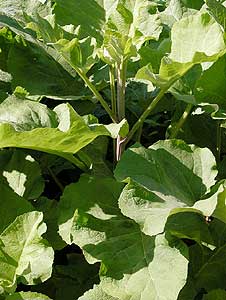 Great Burdock
Great Burdock
Arctium lappa L. (Asteraceae)
Common Names Great burdock, beggar's buttons, burdock, clotbur, lappa.
Description A biennial or perennial 3 to 8 feet in height, with many flowered heads. Leaves are large, broad, and rounded-like those on rhubarb. the tube-shaped flowers are pale pink, deep purple, or white. Big brown, round, bristly burrs are a common characteristic of the plant.
Flowering Period July to October
Range Asia and Europe.
Habitat Fields and roadsides.
Harvest Root of plant's first year of growth; can be harvested anytime.
Duration Biennial
Family Aster
Uses The United States Dispensatory no longer lists this herb as medicinally valuable, but in the past it was quite popular for treating many ailments. In Spain and France it has been used to purify the blood and to cure skin blemishes and minor wounds. In 18th Century America it was prescribed as a cure for gonorrhea and syphilis. In Appalachia, a tea of roots or seeds is used to treat rheumatism and to purify the blood.
Great Burdock Crushed leaves were applied to cool bruises, burns and swellings. Seeds, or the juice from the leaves, taken with honey, were considered a diuretic.